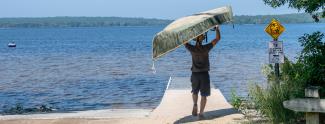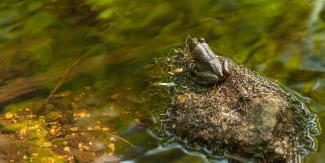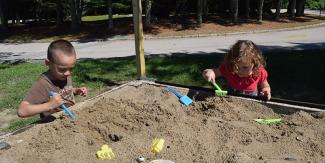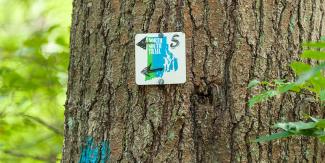Nature-Based Activities
Try some of these outdoor activities on your own or with your family!

50 Nature-Based Activities for Rhode Islanders
There are lots of fun activities you can do right from your home, backyard, or neighborhood. Try some of these activities on your own or with your family!
Print Friendly Flyers

Apps & Virtual Learning
1. Herp Observer app from RI Division of Fish and Wildlife: If you love frogs, toads, salamanders, snakes, and turtles, this is the app for you!
2. iNaturalist app: Snap a photo of any critter or plant you encounter, and submit it to the iNaturalist community, and someone can help you identify it.
3. Seek app: iNaturalist has also created a separate app for kids to use for nature exploration and learning.
4. Merlin app from the Cornell Lab of Ornithology: This free app is great for beginner and expert bird watchers alike. Download the US Northeast Bird Pack to learn about the species right in your own backyard or neighborhood.
5. SkyView app: Simply point your phone or tablet at the sky, and this app will identify the constellations you’re looking at. For Apple Devices / Android Devices
6. Tune in to the Providence Peregrine Cam from the Audubon Society of RI: Watch peregrine falcons tend to their nest, live from the top of the Superman building!
7. Watch the Audubon Society of RI’s raven cam: Audubon’s raven ambassador’s Zach and Lucy are always up to some sort of mischief!
8. Visit with the animals and zookeepers at Roger Williams Park Zoo: Tune into the zoo’s YouTube channel for Zoo School.
9. Virtually visit New England Aquarium: Learn about sea creatures and go behind the scenes.
10. Learn about nature with Audubon at Home: Each week, learn about a different nature theme, do activities, and meet some of Audubon’s animal ambassadors.
11. Learn about wildlife conservation and careers with Conservation Connect from the US Fish & Wildlife Service: Check out this educational video series here.
12. Take an online hunter safety course: If you have ever been interested in learning how to hunt, taking an online safety course is the first step.
13. Follow local eco-organizations on Instagram for fun facts and updates: ri.fishandwildlife | ristateparks | rwpzoo | riaudubon | tnc_rhodeisland | usfws | riurbanrefuge | rinaturalhistory | rieeaconnects | rirrc

Reading & Educator Resources
14. Read all about RI critters and conservation in the Wild Rhode Island Explorer magazine: Learn all about RI critters and local conservation work, do fun activities, and check out the trail camera photo caption contest.
15. Read Ranger Rick online: Through June, Ranger Rick has made all of their issues available online for free!
16. Read about wildlife conservation work in Wild Rhode Island: Read current and past issues of RI Division of Fish and Wildlife’s quarterly newsletter.
17. Check out the Educator Resource Directory from RI Environmental Education Association: Browse the vast network of eco-based programs available in RI for teachers, children, and families.
18. Read a nature book: Call your local library for suggestions. Do you have a young reader at home? The Audubon Society of RI’s has a list of nature books for grades pre-K through 6.

DIY & At-Home Activities
19. Birdwatch: Sit on your front step, backyard, or window and watch the birds right around your home. Keep a list of the species you see. You don’t have to go far, birds are everywhere!
20. Have a bird call impersonation contest with your family: Listen to bird calls outside, and see who can do the best impersonation of your feathered friends!
21. Build a birdhouse: You can build birdhouses to attract different species. Cornell Lab of Ornithology has lots of building templates you can use.
22. Build a bathouse: This is a great way to help bats in your neighborhood. Here are some instructions
23. Start a nature journal: You can use a notebook, pad of paper, or even make your own out of scrap paper. Record the weather, location, time of day, and the things that you see in your yard, on your street, or right outside your window. Draw a picture, write a poem, tell a story. Your journal is your own, and there’s no right or wrong way to start one.
24. Plant an acorn inside: Find an acorn outside that isn’t cracked or broken open, plant in a pot (or place in a cup of water) in a sunny window. See how long it takes to sprout a tiny oak seedling!
25. Go camping in your backyard or in your home: Pitch a tent right in the backyard, or create your own out of blankets and chairs inside. Play nighttime nature sounds like owls, frogs, and crickets. Eat snacks, sing songs, and have fun!
26. Make a food web out of magazine clippings: Search for pictures of animals and plants in magazines and cut them out. Glue them on a piece of paper or spread them out on the table. Connect the living things together by drawing a line or using a piece of string. For example, deer eat plants, so you would draw a connection between the two.
27 Start some seeds indoors: Plant some herbs or veggie seeds in a pot, and place in a sunny window. As the weather gets warmer, you can transplant your seedlings outside to the garden.
28. Make a flipbook: Plant a seed in a pot, then take a picture of the pot every day to document the seed’s growth. Once your seed grows into a seedling, you can print the pictures out and put them in chronological order to make a flip book and watch a time lapse of the seed growing. You can also make a time lapse video with digital photos.
29. Play "Guess that Plant:" Plant some seeds or bulbs in a pot, and take a picture each week of its progress. Post your photo to social media, and ask friends and family to guess what kind of plant it is. It could take 6-8 weeks for folks to figure out the identity of the mystery plant!
30. Build a mini beaver dam: Grab some twigs, leaves, and pebbles. You can even make some “swamp mud” by mixing a little water with some dirt. Use a shallow container (paint tray, top of an egg carton, plastic tray from cookie package, etc.), and try to build your own beaver dam across the container using your collected materials. Test your dam by pouring some water into one side of the container.
31. Make a bat craft: Watch this video by RI Division of Fish and Wildlife to learn all about bats and how to make your very own bat out of a toilet paper tube.
32. Start your own compost pile: Save food scraps and make some compost for the garden.
33. Learn about invasive plant species: Do some research, and look around your property for any invasives. Get out your garden tools and remove those pesky invasive species, the native plants will thank you! RI Wild Plant Society has a bunch of resources about invasive plants.
34. Pick a "sit spot:" Take some time to sit in one spot where you can experience the outdoors every day/week. It could be in your yard, on your front step, or by a window. In your sit spot, take deep breaths, relax, look, and listen. Just enjoy some time with the natural world.
35. Build a brush pile: If you have space in your yard, pile up all of your yard debris. Brush piles are good sources of shelter for rabbits, foxes, snakes, salamanders, and other critters. Learn more about local wildlife.
36. Learn about native plants for pollinators and other wildlife: Check out these resources from the RI Wild Plant Society.
37. Create an animal track station: Clear off a patch of bare soil, or sprinkle some flour in an area of your yard. If you’re using soil, make sure it’s wet/soft enough for animals to leave tracks. Check each day to see if anything has left footprints in your track station. Here’s an easy to use track guide.
38. When it rains, track your stormwater: Put on your rain gear and explore where water goes when it leaves your roof/driveway. Find out where your nearest storm drain is, and make sure it is clear of trash.
39. Make your windows bird-friendly: Birds often collide with windows, which can be fatal.Learn about why this can happen, and how you can prevent it.
40. Learn the cycles of the moon: We are close to a new moon, so you can watch it wax (grow bigger) until the full moon on April 7, then watch it wane (grow smaller again) until a new moon on April 22 starts the whole cycle again! Learn more here about moon phases.
41. Snap some nature photos: Get outside and get creative with your camera!
42. Create your own I Spy scene: Artistically place natural objects (acorns, leaves, twigs, etc.) alongside things you have in your house (toys, craft supplies, etc.) to make a scene. Take a picture of your scene, and come up with a list of things that are hidden in the picture. Challenge your family to find everything in the picture, or upload it to social media and ask your friends to play "I spy." Get some inspiration.
43. Put on a wildlife play: Pick an animal and design a mask to look like that animal. Think about (or look up) what that animal needs and how it behaves, then act out your own mini-play as your creature.
44. Make leaf rubbing artwork: All you need are some leaves, crayons, and paper. Place a piece of paper over your leaf, and rub the crayon firmly over the paper, coloring over the entire leaf.

Outdoors
45. Play a game on the trail: RI Families in Nature has some great ideas for fun in the outdoors.
46. Do a nature scavenger hunt: Create your own, or use this one from RI Families in Nature.
47. Hunt for antlers: Every winter, deer lose their antlers and grow back new ones in the spring. On your next walk in the woods, keep your eyes peeled for these “sheds.”
48.Get up early to watch the sunrise: Wake up with the birds for a peaceful start to your day!
49. Create an Earth Day sidewalk chalk mural: 2020 marks the 50th anniversary of Earth Day. Show your appreciation for our home through art!
50. Go geocaching: Participate in the world’s largest outdoor treasure hunt using the GPS on your cell phone! Learn more


